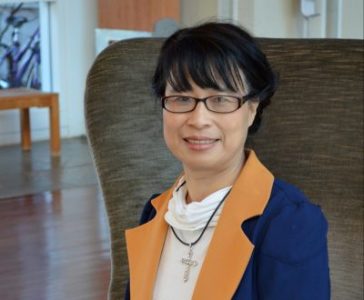New COVID-19 research by Auburn University faculty member Shufen Pan and student Yongfa You is the first to find that urban vegetation could slow the spread of COVID-19, a finding that was published recently in the journal, Geophysical Research Letters.
“Urban vegetation could potentially influence the spread of COVID-19 in several ways, including improving air quality, maintaining psychological well-being and keeping social distancing,” said Pan, assistant professor and director of the GIS and Remote Sensing Laboratory in Auburn’s School of Forestry and Wildlife Sciences.
The unprecedented COVID-19 global pandemic has infected more than 38 million people and has resulted in the deaths of more than 1 million people.
The United States is the epicenter of the pandemic, but the number of confirmed COVID-19 cases among U.S. counties varies greatly, ranging from zero to tens of thousands. The causes behind the large spatial variation in the transmission patterns of COVID-19 remain unclear, Pan said.
“Therefore, there is an urgent need to investigate the potential factors that play a critical role in shaping the transmission patterns of COVID-19, which will be very helpful in controlling the speed and severity of COVID-19 transmission and making optimal decisions to cope with future public health emergencies,” Pan said.
Pan and You explored the effects of multiple factors—including urban vegetation, temperature, population density and the timing of government intervention on COVID-19—on the magnitude and large spatial variation of the COVID-19 confirmed cases across U.S. counties.
“By using multisource data—such as remote sensing products, census data and climate data in conjunction with Google Earth Engine, a big data processing platform—our study shows that each 1-percent increase in the percentage of urban vegetation will lead to a 2.6-percent decrease in cumulative COVID-19 cases,” Pan said. “Additionally, the mediating role of urban vegetation suggests that it could reduce increases in cumulative COVID‐19 cases induced by population density and baseline infection.”
The researchers say the study demonstrates the importance of urban vegetation in times of crisis.
“In addition to directly preventing the spread of COVID-19 by allowing for and encouraging social distancing, urban vegetation could also potentially influence the spread of COVID-19 through improving air quality and maintaining psychological well-being,” Pan said.
She added, that during the crisis, urban green space provides a temporary refuge from family confinement and an opportunity to reduce stress through relaxation, which can improve mental health. For those reasons, she believes increasing the proportion of urban vegetation covering and arranging its spatial layout should play a major part in future urban planning, which has an important impact on individuals’ well-being.
“Our findings highlight the importance of urban vegetation as a resilient infrastructure, especially in times of pandemic crisis,” Pan said. “Increasing the proportion of urban vegetation coverage needs to be incorporated into future urban planning to strengthen the resilience of cities to public health emergencies.
“This research can provide valuable policy implications for the government to achieve sustainable development goals, such as good health and well-being, and resilient and sustainable cities,” she added.
Janaki Alavalapati, dean of the School of Forestry and Wildlife Sciences, said the study is promising, considering today’s health crisis as well as those that may erupt in the future.
“Hopefully, the findings of this research will help to provide additional insights in addressing this pandemic and other emerging diseases,” Alavalapati said.
Hanqin Tian, the Solon and Martha Dixon Professor and director of International Center for Climate and Global Change Research at the school, said the study underscores the important role of trees in ameliorating the effects of the current pandemic as well as other areas of scientific concern.
“Planting more trees in urban areas not only slows down the spread of coronavirus, but also helps the climate,” Tian said. “Urban trees can cool the climate by absorbing carbon dioxide as part of the photosynthesis process and by evaporating water into the air.”
(Written by Teri Greene)










